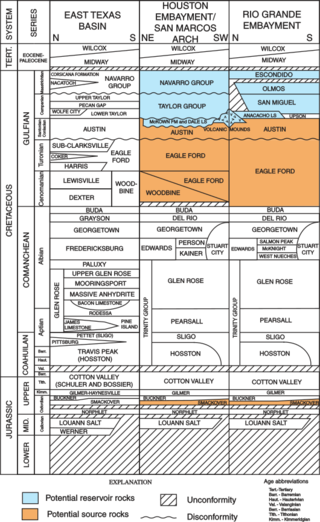
The Glen Rose Formation is a shallow marine to shoreline geological formation from the lower Cretaceous period exposed over a large area from South Central to North Central Texas. The formation is most widely known for the dinosaur footprints and trackways found in the Dinosaur Valley State Park near the town of Glen Rose, Texas, southwest of Fort Worth and at other localities in Central Texas.

Martin G. Lockley is a Welsh palaeontologist. He was educated in the United Kingdom where he obtained degrees and post-doctoral experience in Geology in the 1970s. Since 1980 he has been a professor at the University of Colorado at Denver, (UCD) and is currently a Professor Emeritus. He is best known for work on fossil footprints and was former director of the Dinosaur Tracks Museum at UCD. He is an Associate Curator at the University of Colorado Museum of Natural History and Research Associate at the Denver Museum of Nature and Science. During his years at UCD he earned a BA in 2007 in Spanish with a minor in Religious Studies, became a member of the Scientific and Medical Network and taught and published on the evolution of consciousness.
The Calcários Micríticos da Serra de Aire is a Bathonian geologic formation in Portugal. Fossil sauropod tracks have been reported from the formation.
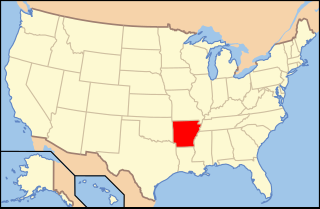
Paleontology in Arkansas refers to paleontological research occurring within or conducted by people from the U.S. state of Arkansas. The fossil record of Arkansas spans from the Ordovician to the Eocene. Nearly all of the state's fossils have come from ancient invertebrate life. During the early Paleozoic, much of Arkansas was covered by seawater. This sea would come to be home to creatures including Archimedes, brachiopods, and conodonts. This sea would begin its withdrawal during the Carboniferous, and by the Permian the entire state was dry land. Terrestrial conditions continued into the Triassic, but during the Jurassic, another sea encroached into the state's southern half. During the Cretaceous the state was still covered by seawater and home to marine invertebrates such as Belemnitella. On land the state was home to long necked sauropod dinosaurs, who left behind footprints and ostrich dinosaurs such as Arkansaurus.

Paleontology in Nebraska refers to paleontological research occurring within or conducted by people from the U.S. state of Nebraska. Nebraska is world-famous as a source of fossils. During the early Paleozoic, Nebraska was covered by a shallow sea that was probably home to creatures like brachiopods, corals, and trilobites. During the Carboniferous, a swampy system of river deltas expanded westward across the state. During the Permian period, the state continued to be mostly dry land. The Triassic and Jurassic are missing from the local rock record, but evidence suggests that during the Cretaceous the state was covered by the Western Interior Seaway, where ammonites, fish, sea turtles, and plesiosaurs swam. The coasts of this sea were home to flowers and dinosaurs. During the early Cenozoic, the sea withdrew and the state was home to mammals like camels and rhinoceros. Ice Age Nebraska was subject to glacial activity and home to creatures like the giant bear Arctodus, horses, mammoths, mastodon, shovel-tusked proboscideans, and Saber-toothed cats. Local Native Americans devised mythical explanations for fossils like attributing them to water monsters killed by their enemies, the thunderbirds. After formally trained scientists began investigating local fossils, major finds like the Agate Springs mammal bone beds occurred. The Pleistocene mammoths Mammuthus primigenius, Mammuthus columbi, and Mammuthus imperator are the Nebraska state fossils.

Paleontology in Kansas refers to paleontological research occurring within or conducted by people from the U.S. state of Kansas. Kansas has been the source of some of the most spectacular fossil discoveries in US history. The fossil record of Kansas spans from the Cambrian to the Pleistocene. From the Cambrian to the Devonian, Kansas was covered by a shallow sea. During the ensuing Carboniferous the local sea level began to rise and fall. When sea levels were low the state was home to richly vegetated deltaic swamps where early amphibians and reptiles lived. Seas expanded across most of the state again during the Permian, but on land the state was home to thousands of different insect species. The popular pterosaur Pteranodon is best known from this state. During the early part of the Cenozoic era Kansas became a savannah environment. Later, during the Ice Age, glaciers briefly entered the state, which was home to camels, mammoths, mastodons, and saber-teeth. Local fossils may have inspired Native Americans to regard some local hills as the homes of sacred spirit animals. Major scientific discoveries in Kansas included the pterosaur Pteranodon and a fossil of the fish Xiphactinus that died in the act of swallowing another fish.

Paleontology in Texas refers to paleontological research occurring within or conducted by people from the U.S. state of Texas. Author Marian Murray has remarked that "Texas is as big for fossils as it is for everything else." Some of the most important fossil finds in United States history have come from Texas. Fossils can be found throughout most of the state. The fossil record of Texas spans almost the entire geologic column from Precambrian to Pleistocene. Shark teeth are probably the state's most common fossil. During the early Paleozoic era Texas was covered by a sea that would later be home to creatures like brachiopods, cephalopods, graptolites, and trilobites. Little is known about the state's Devonian and early Carboniferous life. However, evidence indicates that during the late Carboniferous the state was home to marine life, land plants and early reptiles. During the Permian, the seas largely shrank away, but nevertheless coral reefs formed in the state. The rest of Texas was a coastal plain inhabited by early relatives of mammals like Dimetrodon and Edaphosaurus. During the Triassic, a great river system formed in the state that was inhabited by crocodile-like phytosaurs. Little is known about Jurassic Texas, but there are fossil aquatic invertebrates of this age like ammonites in the state. During the Early Cretaceous local large sauropods and theropods left a great abundance of footprints. Later in the Cretaceous, the state was covered by the Western Interior Seaway and home to creatures like mosasaurs, plesiosaurs, and few icthyosaurs. Early Cenozoic Texas still contained areas covered in seawater where invertebrates and sharks lived. On land the state would come to be home to creatures like glyptodonts, mammoths, mastodons, saber-toothed cats, giant ground sloths, titanotheres, uintatheres, and dire wolves. Archaeological evidence suggests that local Native Americans knew about local fossils. Formally trained scientists were already investigating the state's fossils by the late 1800s. In 1938, a major dinosaur footprint find occurred near Glen Rose. Pleurocoelus was the Texas state dinosaur from 1997 to 2009, when it was replaced by Paluxysaurus jonesi after the Texan fossils once referred to the former species were reclassified to a new genus.

Paleontology in Wyoming includes research into the prehistoric life of the U.S. state of Wyoming as well as investigations conducted by Wyomingite researchers and institutions into ancient life occurring elsewhere.
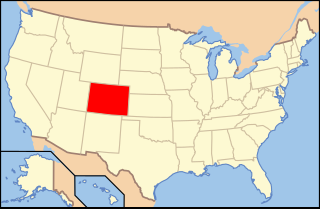
Paleontology in Colorado refers to paleontological research occurring within or conducted by people from the U.S. state of Colorado. The geologic column of Colorado spans about one third of Earth's history. Fossils can be found almost everywhere in the state but are not evenly distributed among all the ages of the state's rocks. During the early Paleozoic, Colorado was covered by a warm shallow sea that would come to be home to creatures like brachiopods, conodonts, ostracoderms, sharks and trilobites. This sea withdrew from the state between the Silurian and early Devonian leaving a gap in the local rock record. It returned during the Carboniferous. Areas of the state not submerged were richly vegetated and inhabited by amphibians that left behind footprints that would later fossilize. During the Permian, the sea withdrew and alluvial fans and sand dunes spread across the state. Many trace fossils are known from these deposits.
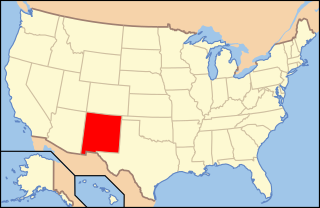
Paleontology in New Mexico refers to paleontological research occurring within or conducted by people from the U.S. state of New Mexico. The fossil record of New Mexico is exceptionally complete and spans almost the entire stratigraphic column. More than 3,300 different kinds of fossil organisms have been found in the state. Of these more than 700 of these were new to science and more than 100 of those were type species for new genera. During the early Paleozoic, southern and western New Mexico were submerged by a warm shallow sea that would come to be home to creatures including brachiopods, bryozoans, cartilaginous fishes, corals, graptolites, nautiloids, placoderms, and trilobites. During the Ordovician the state was home to algal reefs up to 300 feet high. During the Carboniferous, a richly vegetated island chain emerged from the local sea. Coral reefs formed in the state's seas while terrestrial regions of the state dried and were home to sand dunes. Local wildlife included Edaphosaurus, Ophiacodon, and Sphenacodon.

Paleontology in Utah refers to paleontological research occurring within or conducted by people from the U.S. state of Utah. Utah has a rich fossil record spanning almost all of the geologic column. During the Precambrian, the area of northeastern Utah now occupied by the Uinta Mountains was a shallow sea which was home to simple microorganisms. During the early Paleozoic Utah was still largely covered in seawater. The state's Paleozoic seas would come to be home to creatures like brachiopods, fishes, and trilobites. During the Permian the state came to resemble the Sahara desert and was home to amphibians, early relatives of mammals, and reptiles. During the Triassic about half of the state was covered by a sea home to creatures like the cephalopod Meekoceras, while dinosaurs whose footprints would later fossilize roamed the forests on land. Sand dunes returned during the Early Jurassic. During the Cretaceous the state was covered by the sea for the last time. The sea gave way to a complex of lakes during the Cenozoic era. Later, these lakes dissipated and the state was home to short-faced bears, bison, musk oxen, saber teeth, and giant ground sloths. Local Native Americans devised myths to explain fossils. Formally trained scientists have been aware of local fossils since at least the late 19th century. Major local finds include the bonebeds of Dinosaur National Monument. The Jurassic dinosaur Allosaurus fragilis is the Utah state fossil.
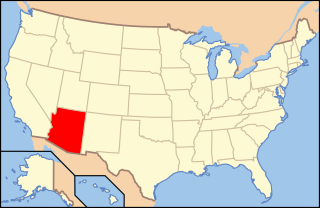
Paleontology in Arizona refers to paleontological research occurring within or conducted by people from the U.S. state of Arizona. The fossil record of Arizona dates to the Precambrian. During the Precambrian, Arizona was home to a shallow sea which was home to jellyfish and stromatolite-forming bacteria. This sea was still in place during the Cambrian period of the Paleozoic era and was home to brachiopods and trilobites, but it withdrew during the Ordovician and Silurian. The sea returned during the Devonian and was home to brachiopods, corals, and fishes. Sea levels began to rise and fall during the Carboniferous, leaving most of the state a richly vegetated coastal plain during the low spells. During the Permian, Arizona was richly vegetated but was submerged by seawater late in the period.

Paleontology in Washington encompasses paleontological research occurring within or conducted by people from the U.S. state of Washington. Washington has a rich fossil record spanning almost the entire geologic column. Its fossil record shows an unusually great diversity of preservational types including carbonization, petrifaction, permineralization, molds, and cast. Early Paleozoic Washington would come to be home to creatures like archaeocyathids, brachiopods, bryozoans, cephalopods, corals, and trilobites. While some Mesozoic fossils are known, few dinosaur remains have been found in the state. Only about two-thirds of the state's land mass had come together by the time the Mesozoic ended. In the Cenozoic the state's sea began to withdraw towards the west, while local terrestrial environments were home to a rich variety of trees and insects. Vertebrates would come to include the horse Hipparion, bison, camels, caribou, oreodonts. Later, during the Ice Age, the northern third of the state was covered in glaciers while creatures like bison, caribou, woolly mammoths, mastodons, and rhinoceros roamed elsewhere in the state. The Pleistocene Columbian Mammoth, Mammuthus columbi is the Washington state fossil.

The Tensleep Sandstone is a geological formation of Pennsylvanian to very early Permian age in Wyoming.
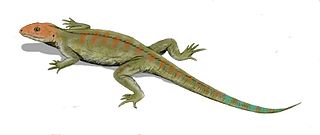
Steganoposaurus is an ichnogenus of fossil reptile footprints. The ichnospecies Steganoposaurus belli, was erected for footprints discovered in Wyoming's Tensleep Sandstone. The find was first reported to the scientific literature by Edward Branson and Maurice Mehl in 1932. This creature was originally presumed to be an amphibian, but the toe prints it left behind were pointed like a reptile's rather than round like an amphibians. The actual trackmaker may have been similar to the genus Hylonomus. The ichnogenus Tridentichnus are similar footprints preserved in the Supai Formation of Arizona.
Tridentichnus is an ichnogenus of fossil footprints. The Tridentichnus trackmaker was a relatively large animal with five toes on its hind feet. They are preserved in the Supai Formation and located in Arizona. The ichnospecies Steganoposaurus belli are similar footprints preserved in the Tensleep Sandstone of Wyoming.
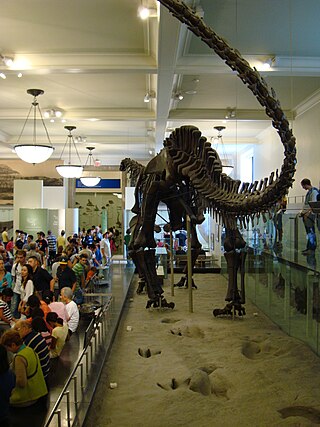
The 20th century in ichnology refers to advances made between the years 1900 and 1999 in the scientific study of trace fossils, the preserved record of the behavior and physiological processes of ancient life forms, especially fossil footprints. Significant fossil trackway discoveries began almost immediately after the start of the 20th century with the 1900 discovery at Ipolytarnoc, Hungary of a wide variety of bird and mammal footprints left behind during the early Miocene. Not long after, fossil Iguanodon footprints were discovered in Sussex, England, a discovery that probably served as the inspiration for Sir Arthur Conan Doyle's The Lost World.

The 19th century in ichnology refers to advances made between the years 1800 and 1899 in the scientific study of trace fossils, the preserved record of the behavior and physiological processes of ancient life forms, especially fossil footprints. The 19th century was notably the first century in which fossil footprints received scholarly attention. British paleontologist William Buckland performed the first true scientific research on the subject during the early 1830s.

Limnopus is an ichnogenus of ancient tetrapod footprint. Its footprints have been found in Moscovian aged-rocks situated in Alveley, Shropshire, England, Colorado and West Virginia. The Limnopus tracks were probably made by Diadectes.
Gwyneddichnium is an ichnogenus from the Late Triassic of North America and Europe. It represents a form of reptile footprints and trackways, likely produced by small tanystropheids such as Tanytrachelos. Gwyneddichnium includes a single species, Gwyneddichnium major. Two other proposed species, G. elongatum and G. minore, are indistinguishable from G. major apart from their smaller size and minor taphonomic discrepancies. As a result, they are considered junior synonyms of G. major.
















